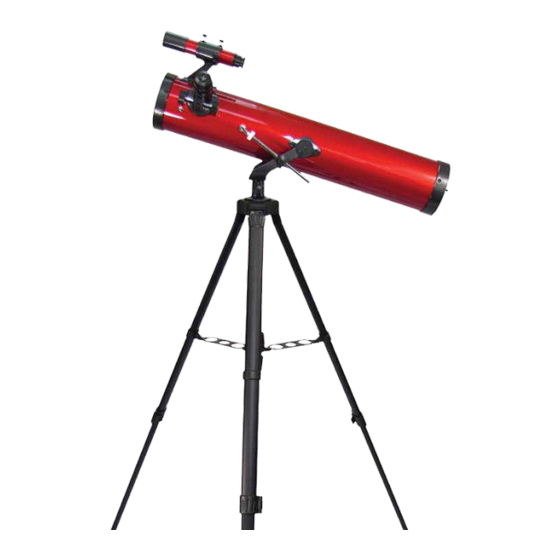
Table of Contents
Advertisement
©2009 CARSON OPTICAL
HAUPPAUGE NY 11788
www.carsonoptical.com
MADE IN CHINA
7
Carson Optical
35 Gilpin Avenue
Hauppauge, NY 11788-4723
Phone: 631-963-5000
Fax: 631-427-6749
©2007 CARSON OPTICAL
For information, call toll-free: 1-800-967-8427
HAUPPAUGE NY 11788
www.carson-optical.com
info@carsonoptical.com / sales@carsonoptical.com / www.carsonoptical.com
MADE IN CHINA
©2009 CARSON OPTICAL
HAUPPAUGE NY 11788
www.carsonoptical.com
MADE IN TAIWAN
50668 00573
1
©2011 CARSON OPTICAL
HAUPPAUGE NY 11788
www.carsonoptical.com
MADE IN CHINA
RP-100 TELESCOPE
Instruction Manual
Advertisement
Table of Contents

Summary of Contents for Carson RP-100
- Page 1 RP-100 TELESCOPE Instruction Manual ©2009 CARSON OPTICAL HAUPPAUGE NY 11788 www.carsonoptical.com MADE IN CHINA 50668 00573 Carson Optical 35 Gilpin Avenue Hauppauge, NY 11788-4723 Phone: 631-963-5000 Fax: 631-427-6749 ©2007 CARSON OPTICAL ©2011 CARSON OPTICAL For information, call toll-free: 1-800-967-8427 HAUPPAUGE NY 11788 HAUPPAUGE NY 11788 www.carsonoptical.com...
-
Page 2: Table Of Contents
Congratulations on your purchase of a Carson RP-100 Red Planet Series telescope. This telescope features an easy-to-use design and high perfor- Table of Contents: mance optics that are perfect for beginning astronomers looking to explore the wonders of outer space and the world around them. Please read this man- Introduction ual carefully to ensure that you assemble and use your telescope correctly. - Page 3 Fig.1 Fig.3 Fig.2 Fig.4...
- Page 4 Fig.5 Fig.7 Fig.6 Fig.8...
-
Page 5: Setting Up Your Tripod
Key to Figures 1-8: Assembly of your Red Planet Telescope: Setting Up Your Tripod: 10x30mm Finder Scope Focuser The aluminum tripod comes preassembled and ready-to-use. Remove the Eyepiece tripod from the box and pull apart the legs. Gently push down the tripod Focus Knobs braces (Fig. 6-21) until they are in the lowest position. Turn the tightening Optical Tube Assembly... -
Page 6: Attaching The Eyepieces
Calculating Power: Attaching the Eyepieces: Insert the Huygenian 20mm eyepiece (Fig. 4-3) into the focuser (Fig. 4-2) and tighten down using the focuser locking screw (Fig. 4-15). The magnification of a telescope depends on both the focal length of your telescope as well as the eyepiece you use. There is a simple formula you can You have now completed the assembly of your Red Planet telescope. use to determine the magnification you are using at any given time. Simply We will now need to make the necessary adjustments in order to use your divide the focal length of the telescope by the focal length of the eyepiece. telescope properly. -
Page 7: Using The Telescope
Using the Telescope: to adjust to the dark before making observations. Using a red filtered flashlight to view charts and your telescope components is recommended to preserve your night sight. The best viewing Once you have properly assembled and aligned your telescope you are finally conditions are when the sky is inky black. ready to start using it. • H azy skies, pollution, clouds and moisture can all affect the clarity • T o locate an object using the telescope, first loosen the horizontal of your viewing image. lock knob (Fig. 1-7) and the altitude rod coarse adjustment lock knob • A void touching the eyepiece or optical tube while looking through (Fig. 3-14) allowing the telescope to rotate along both axes. Look the telescope. -
Page 8: Collimation Of Optics
Fig.9 Collimation of the Optics: The internal optics of the telescope have already been “collimated” or “aligned” at the factory. However, rough handling of the telescope may knock the optics out of collimation, resulting in poor optical performance. Please refer to Fig. 9 to better understand the internal layout of your telescope. To determine if your telescope needs collimation perform the following steps: • R emove the eyepiece (Fig. 1-3) from the focuser (Fig. 1-2) and turn the focusing knob (Fig. 1-4) until the tube is at its innermost position. -
Page 9: Adjusting The Primary Mirror
Specifications: Adjusting the Primary Mirror: If the telescope is properly collimated you should see the diagonal mirror (See Fig. 10) at the exact center of the primary mirror. If the diagonal Optical Design: Newtonian Reflector mirror appears off-center (See Fig. 11) you will need to adjust the primary Aperture: 76mm (2.99”) mirror (See Fig.9) located on the outside lower-end of the main tube. Focal Length: 700mm (27.56”) To do this you will first need to loosen the primary mirror locking screws Focal Ratio: 9.21 (Fig. 8-28). These are the screws that are flush against the surface of the Finder Scope: 10x30mm telescope. Then alternately loosen and tighten the primary mirror tilt screws Eyepiece 1: Huygenian 20mm Erecting (Fig. 8-29) until the diagonal mirror is centered inside the primary mirror. -
Page 10: Warranty Information
Warranty Information: This Carson product is warranted to be free from defects in material and workmanship for a period of one year from date of purchase. During this period Carson will, at its option and without charge, either repair any part or assembly of parts found to be defective in material or workmanship, or replace this Carson product with a Carson product of comparable value and condition, subject to the limitations and exclusions noted herein.















Need help?
Do you have a question about the RP-100 and is the answer not in the manual?
Questions and answers